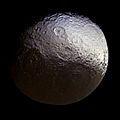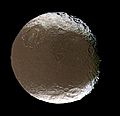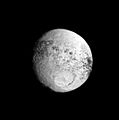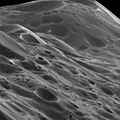Iapetus (moon) facts for kids
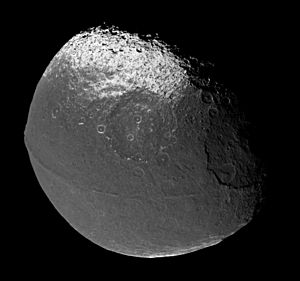
Iapetus is a large moon that orbits the planet Saturn. It was first seen by an astronomer named Giovanni Domenico Cassini in 1671. Iapetus is one of Saturn's most interesting moons because of its very unusual appearance.
One side of Iapetus is extremely bright, almost like fresh snow. The other side is very dark, like charcoal. This makes Iapetus look like it has two different halves. Scientists believe the bright side is covered in ice, while the dark side is coated in a black, dusty material.
Iapetus also has a unique feature: a huge ridge that runs around its middle, right along its equator. This ridge is very tall, in some places reaching up to 10 kilometers (6 miles) high. It makes the moon look a bit like a walnut. The Cassini-Huygens spacecraft discovered this ridge on December 31, 2004.
Iapetus spins very slowly. It takes about 79 Earth days for Iapetus to complete one full rotation. This slow spin means that one side of the moon always faces forward as it travels around Saturn.
Contents
Discovering Iapetus
Giovanni Domenico Cassini was the first person to spot Iapetus. He noticed it in 1671 using his telescope. When Cassini first observed Iapetus, he could only see it when it was on one side of Saturn. He figured out that one side of the moon must be much darker than the other. This idea was later confirmed by the Voyager 1 spacecraft many years later.
The Two-Tone Moon
Why Iapetus Has Bright and Dark Sides
The most striking thing about Iapetus is its two-tone color. One half of the moon, called the leading hemisphere, is very dark. This is the side that faces forward as Iapetus moves in its orbit around Saturn. The other half, the trailing hemisphere, is very bright.
Scientists think the dark material is made of carbon-rich dust. This dust might come from other small moons or space debris that Iapetus collects as it orbits Saturn. The dark material absorbs sunlight, making that side of the moon warmer. This warmth causes ice on the dark side to turn into gas and move to the colder, brighter side, making the bright side even brighter.
The Equatorial Ridge
Iapetus's Mysterious Mountain Range
The giant ridge around Iapetus's equator is one of the solar system's biggest mysteries. It's like a mountain range that wraps all the way around the moon. Some parts of this ridge are taller than Mount Everest on Earth!
Scientists are still trying to figure out how this ridge formed. Some ideas suggest it could be the remains of a collapsed ring system that once orbited Iapetus. Another idea is that it formed very early in the moon's history, perhaps from a slow-motion collision or a unique geological process.
Orbit and Rotation
How Iapetus Moves Around Saturn
Iapetus has a very unusual orbit compared to Saturn's other large moons. Its orbit is tilted quite a bit compared to Saturn's equator and its rings. This means that from Iapetus, you would see Saturn's rings at a steep angle, not just edge-on.
As mentioned, Iapetus rotates very slowly. This slow rotation is called "synchronous rotation." It means that the same side of Iapetus always faces Saturn, just like our Moon always shows the same face to Earth. However, because Iapetus's orbit is tilted, it still appears to wobble a bit from Saturn's perspective.
Images for kids
-
Artist's impression of the Phoebe ring, which dwarfs Saturn's main rings
See also
 In Spanish: Jápeto (satélite) para niños
In Spanish: Jápeto (satélite) para niños



